
Date: July 14, 2021
Location: Lat: 34.650304°, Lon: -49.650924°
Dive depth range: 1,201 - 1,247 meters (3,940 - 4,091 feet)
Access Dive Summary and ROV Data
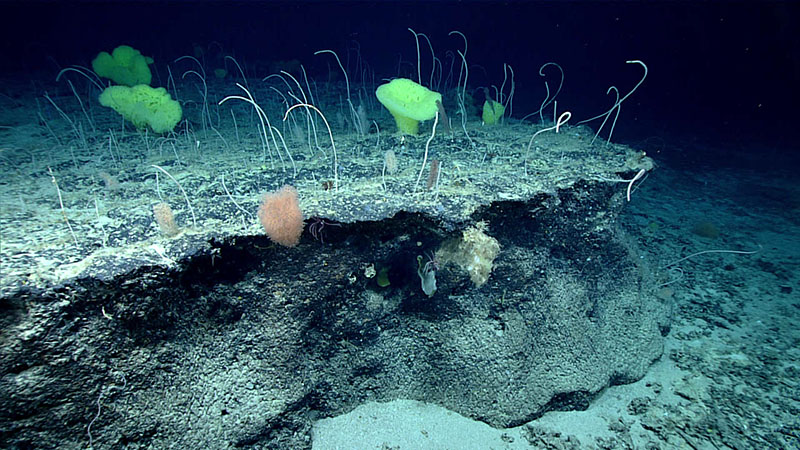
During Dive 11 of the 2021 North Atlantic Stepping Stones expedition, we discovered what is defined by the Oslo/Paris Convention (OSPAR) as a multispecies coral garden (100 - 700 coral colonies per every 100 square meter). The coral garden habitat was dominated by Calyptophora clinata whip corals and dotted with other coral species, including Bathypathes, Thouraella, Acanella, Chrysogorgia, and Parantipathes. This image shows part of the large area of coral garden habitat on top of a ledge outcrop. Image courtesy of NOAA Ocean Exploration, 2021 North Atlantic Stepping Stones: New England and Corner Rise Seamounts. Download largest version (jpg, 1.5 MB).
Dive 11 of the 2021 North Atlantic Stepping Stones expedition was the eighth and final dive of the expedition on seamounts within the Corner Rise Seamount Chain. During the dive, we explored a ridge feature on the eastern part of Caloosahatchee Seamount, which is located in the central portion of the seamount chain.
At the start of the dive, we observed large sediment ripples on the seafloor in a dark and light striped pattern that supported a surprising diversity and density of marine life. As we climbed the ridge, geology was dominated by coarse biogenic sediments often topped with a layer of coral rubble, as well as regions with smooth carbonate pavement encrusted in ferromanganese. These areas of pavement and platforms supported higher densities of corals than seen within the sediment ripples. Near the end of the dive, in shallower depths, the carbonate substrate was variably eroded, creating some interesting ledges, fractures, and small platforms. Biology within this area was very different from what was observed earlier on the dive, with minimal large colonies of corals and sponges, but high densities of biological turnover of sediments.
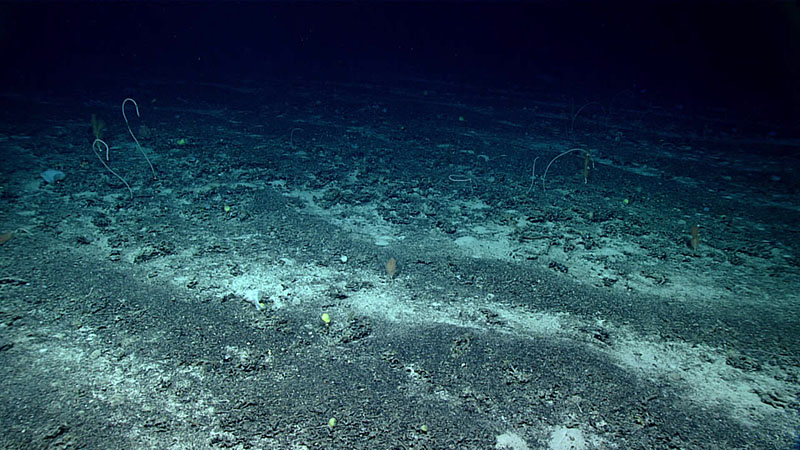
Upon reaching seafloor of Caloosahatchee Seamount on Dive 11 of the 2021 North Atlantic Stepping Stones expedition, large sediment ripples were observed where ferromanganese-stained coral rubble was built up on the leeward side of the strong current flow direction with white carbonate sediments in between the ripples, creating a dark and light striped pattern. Image courtesy of NOAA Ocean Exploration, 2021 North Atlantic Stepping Stones: New England and Corner Rise Seamounts. Download largest version (jpg, 1.5 MB).
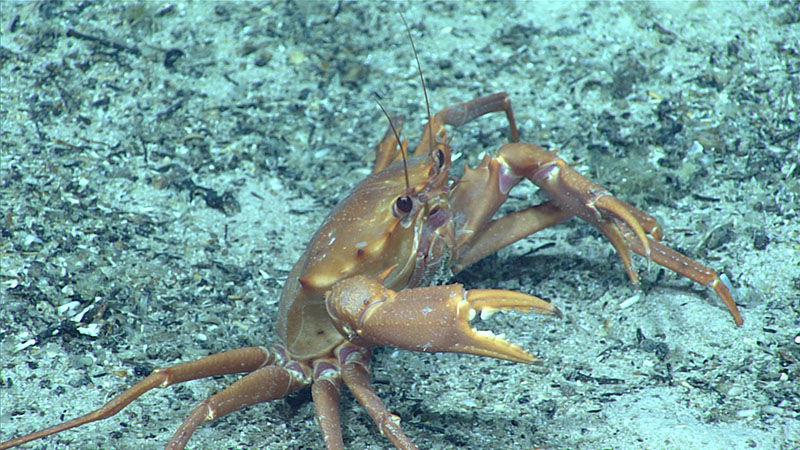
Towards the end of Dive 11 of the 2021 North Atlantic Stepping Stones expedition, we moved from stable ripples and pavement to softer sediments with smaller fractions of broken paleo reef. The seafloor here was pockmarked with circular patches of turned-over sediments, and we also observed larger scar marks that were likely feeding holds for fish and/or Chaceon crabs — like the one pictured here. Image courtesy of NOAA Ocean Exploration, 2021 North Atlantic Stepping Stones: New England and Corner Rise Seamounts. Download largest version (jpg, 1.5 MB).
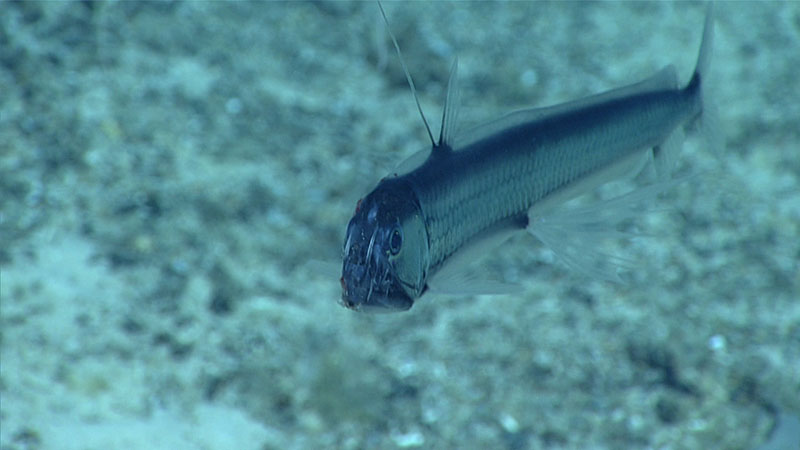
Dive 11 of the 2021 North Atlantic Stepping Stones expedition was particularly abundant for fish species, with multiple oreo fish, black dogfish, Codling, lanternfish, a snubnose spiny eel, and, at the very end of the dive, this midwater viperfish with an impressive set of chompers. Image courtesy of NOAA Ocean Exploration, 2021 North Atlantic Stepping Stones: New England and Corner Rise Seamounts. Download largest version (jpg, 739 KB).
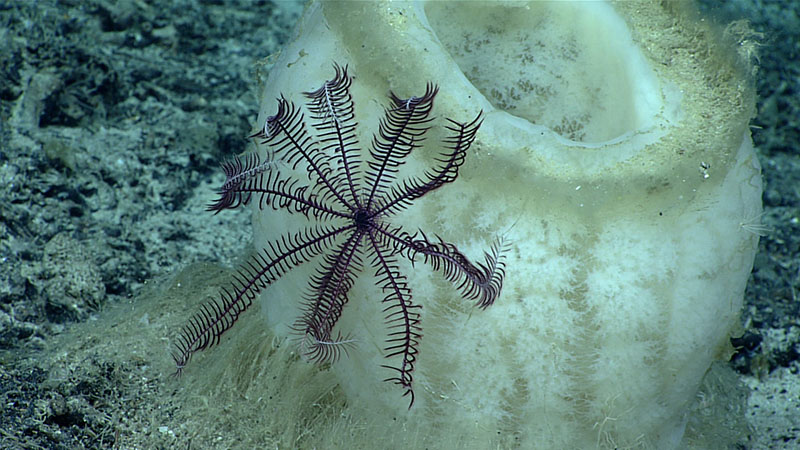
Overall, sponges were less dominant during Dive 11 of the 2021 North Atlantic Stepping Stones expedition than on previous expedition dives. This glass vase sponge was seen providing a home for a beautiful crinoid at a depth of 1,240 meters (4,068 feet). Image courtesy of NOAA Ocean Exploration, 2021 North Atlantic Stepping Stones: New England and Corner Rise Seamounts. Download largest version (jpg, 1.2 MB).

Glacial dropstones of various sizes were observed sporadically throughout Dive 11 of the 2021 North Atlantic Stepping Stones expedition. These rocks likely were incorporated into glaciers during the Last Glacial Maximum, approximately 20,000 years ago, and dropped to the seafloor as floating ice sheets began to melt and lose their loads. This particular dropstone lends its dark appearance to a ferromanganese coating, which, given the slow accumulation rate of the coating, suggests the rock has been in this area for quite some time. This dropstone is also providing habitat for various organisms such as sea stars and sponges. Image courtesy of NOAA Ocean Exploration, 2021 North Atlantic Stepping Stones: New England and Corner Rise Seamounts. Download largest version (jpg, 1.8 MB).
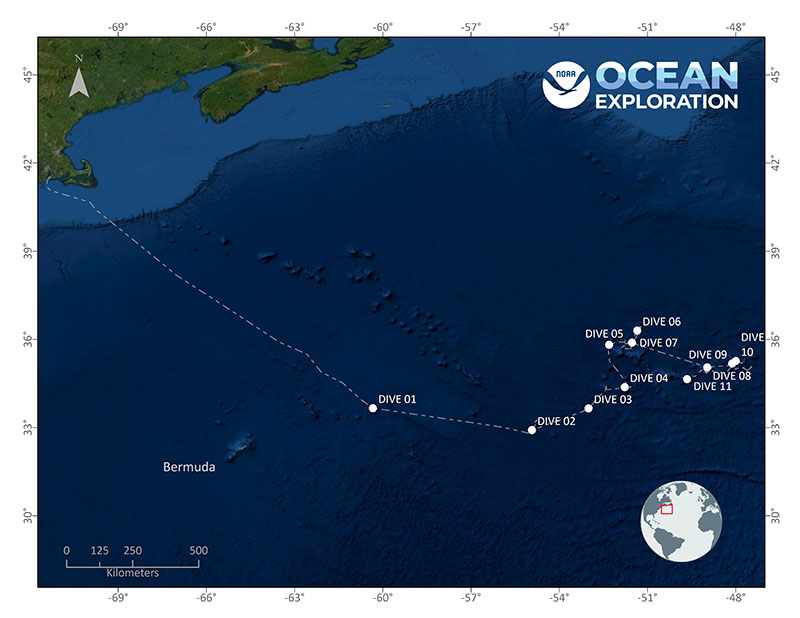
Location of Dive 11 of the 2021 North Atlantic Stepping Stones expedition on July 14, 2021. Map courtesy of NOAA Ocean Exploration, 2021 North Atlantic Stepping Stones: New England and Corner Rise Seamounts. Download largest version (jpg, 3 MB).
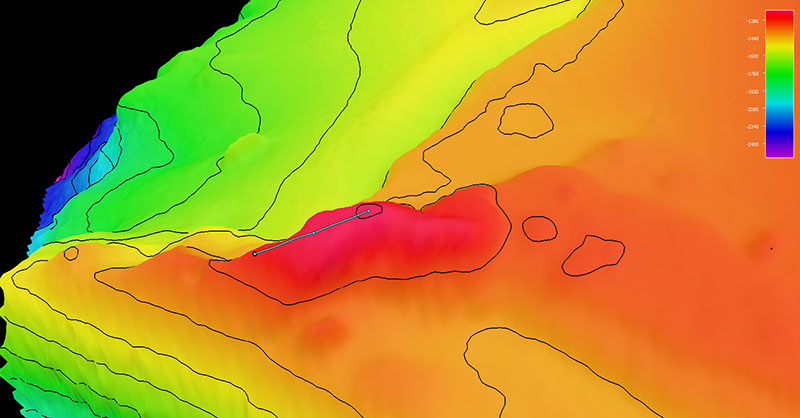
Image showing the dive track of Dive 11 of the 2021 North Atlantic Stepping Stones expedition. Scale is water depth in meters. Image courtesy of NOAA Ocean Exploration, 2021 North Atlantic Stepping Stones: New England and Corner Rise Seamounts. Download largest version (jpg, 609 KB).